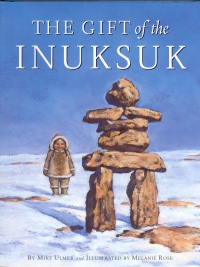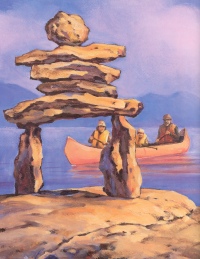| ________________
CM . . .
. Volume XI Number 8 . . . . December 10, 2004
excerpt:
As Ulmer points out in the book's opening pages, "The Gift of the Inuksuk is not an Inuit legend." However, the story Ulmer creates is his explanation of how the Inuksuit (the plural of Inuksuk) might have come into being. In lieu of the "once upon a time" opening, Ulmer commences with "Many lives ago" as he introduces his central character, a little Inuit girl. She was called Ukaliq (which means Arctic hare) by her father because of her being small, inquisitive and always running about. While Ukaliq learned various skills from her mother, she also became aware of the relationship between the people, the land and the various animals which provided food, clothing and shelter. Wherever Ukaliq was, she would wrest stones from the ground and would pile them into stone friends or what we now call Inuksuit. At this point in the story, the stone piles had no real functional purpose; however, that situation was to change when Ukaliq's fathers and brothers embarked on the annual hunt of the migrating caribou. During their absence, a great snow storm arose, and Ukaliq worried that the older male family members might not be able to find their way home. With the assistance of her younger siblings, Ukaliq disassembled the Inuksuit and then reassembled them: Ukaliq and her bother and sisters shifted one stone man only as far as could be seen through the snow from another. Ukaliq showed the children how to put sticks inside the figures to create arms to point toward home.
Ulmer's story is somewhat even, and Ukaliq's rationale for initially creating the Inuksuit remains unclear. As well, the transition from Ukaliq's creating her stone friends and the adult male family members going off to hunt is most abrupt. Young listeners/readers will wonder, if not ask, where Ukaliq's mother is during the storm as she is neither seen nor mentioned. Rose's illustrations, rendered in oils, are a combination of double page spreads and full pages, the latter each facing a page of text which also incorporates a smaller illustration. Rose has effectively captured the stark terrain of Canada's far north, especially in winter, but she also reveals its brief summer splendor. She is particularly good at capturing the varying colours of the northern sky. However, some children who are concerned with accuracy might question Rose's rendering of a teepee-like tent as the family's dwelling as none of her illustrations have indicated the presence of trees which would be necessary to provide the structure's framing poles. Nonetheless, The Gift of the Inuksuk is worthy of purchase by school and public libraries. The storyline does transmit the values of the Inuit who recognized the connectedness of their lives to the land and resources around them, and Rose's realistically rendered illustrations reinforce the text. Recommended. Dave Jenkinson teaches courses in children's and adolescent literature at the Faculty of Education, the University of Manitoba.
To comment
on this title or this review, send mail to cm@umanitoba.ca.
Copyright © the Manitoba Library Association. Reproduction for personal
use is permitted only if this copyright notice is maintained. Any
other reproduction is prohibited without permission.
NEXT REVIEW |TABLE OF CONTENTS FOR THIS ISSUE
- December 10, 2004.
AUTHORS
| TITLES | MEDIA REVIEWS
| PROFILES
| BACK ISSUES
| SEARCH | CMARCHIVE
| HOME |

 Ukaliq's idea is successful, and the next day, not only do her father and brothers return, but the
migrating caribou also follow the Inuksuit and play their role in the cycle of life. The Inuksuk,
which means "in the image of man," then spread across the North and found other practical uses,
uses which persist even today.
Ukaliq's idea is successful, and the next day, not only do her father and brothers return, but the
migrating caribou also follow the Inuksuit and play their role in the cycle of life. The Inuksuk,
which means "in the image of man," then spread across the North and found other practical uses,
uses which persist even today.